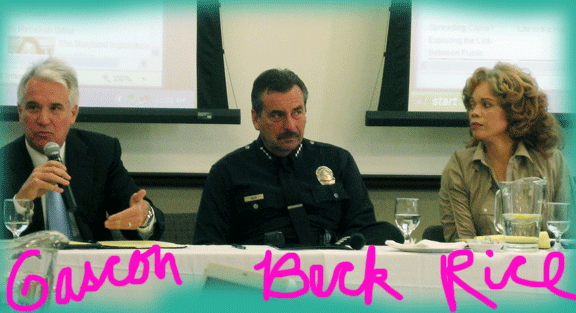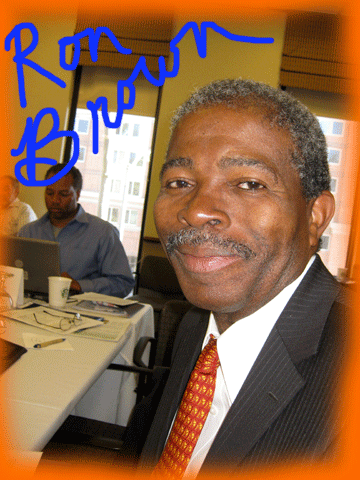
Last week two dozen California reporters—myself included—met with state and local officials and criminal justice experts on the USC campus to talk about California’s Three Strikes law. The idea of the symposium was to encourage more informed and nuanced reporting on criminal justice issues in general, and the Three Strikes law in particular.
The event was sponsored by New York’s John Jay College of Criminal Justice’s Center on Media, Crime and Justice and conceived by Stephen Handelman, the Center’s director, and my pal Joe Domanick, who is the center’s associate director and an expert on the Three Strikes law, since he wrote the most authoritative book on the topic.
For two full days straight, there were panels and Q & A sessions with such people as Matthew Cate, the head of the California Department of Corrections, LA District Attorney, Steve Cooley, Civil Rights lawyer Connie Rice, San Francisco DA, George Gascon, LA’s new head Public Defender Ron Brown, former state senators Tom Hayden and Gloria Romero, plus a pile of academics and advocates from both ends of the political spectrum. There were also two men who had been put away for life by the law, but who had managed to get their cases reconsidered.
Unlike with most such gatherings, many of the officials and experts who came to be on panels, stayed on to become part of the small intense audience.
In broad strokes, the discussion focused on what good or harm the law had done, and what ought to be done about it now. Should it be left as is? Modified? Or should it be done away with?
Most who came seemed eager to share what they knew and the opinions among those who have dealt the most closely with the law were often surprising.
But, before we get to that, a little history on the law itself:
HOW THREE STRIKES WAS BORN
When California’s Three Strikes law was passed as a voter initiative in 1993, it was in response to two murders—that of Kimber Reynolds and of 12-year old Polly Klass.
While Mike Reynolds, Kimber’s father, was the driving force behind the law, it was the death of Polly Klass got the attention of the California electorate.
The death of a 12-year-old is unimaginably tragic under any circumstances. But Polly was kidnapped from her bedroom in front of her two schools friends, there for a sleepover, by a butcher knife-wielding ex convict named Richard Allen Davis who assaulted the girl, then strangled her. Even worse—if anything can be worse—was the fact that Davis should not, by any sane measure, have been on the street at all. A glance at his record showed an emotionally disturbed repeat offender with a horrorshow childhood, a pattern of escalating crimes that included a string of burglaries and car thefts, an armed abduction of a woman and attempted rape, a brutal assault on another woman in the course of a burglary, a second attempted kidnapping, a home invasion, and the robbery of a woman at knifepoint. It is alleged that he also robbed a bank and a couple of stores. Oh, yes, and Davis set cats on fire as a kid and used dogs for knife throwing practice.
In other words, Davis was a man whose past screamed that he was going to hurt somebody badly if he got the chance.
But due to plea deals and an ill thought out change in California sentencing laws, while Davis was sent to prison multiple times, he never seemed to stay there very long.
Add the death of Polly Klass to the high profile murder of photographer Mike Reynolds’s 18-year-old daughter, Kimber, shot during a botched purse snatching by a meth-addict, and an angry and frightened populace passed the statewide initiative named for the baseball metaphor with a whopping 72 to 28 margin.
The idea seemed solid: if a repeat offender with a past of serious and violent felonies committed a third such crime, that offender would be sentenced to a mandatory 25 to life: three strikes and you’re out.
Unfortunately, the law that went on the books was not exactly what the voters had imagined they were getting, in that it allowed prosecutors vast latitude. This meant that, instead of merely sweeping up potential Richard Allen Davises in its oversized net, the statute also doled out 25-to-life sentences to people for crimes that were neither violent nor serious. In fact, according to Anthony Simbol, the director of the criminal justice section of the California legislative Analyst’s office, 53 percent of those serving life sentences under three strikes are there for violent and/or serious crimes. But 47 percent are serving life sentences sentence for non-violent, non-serious crimes.
In 2004, those concerned that the law was being misused, put an initiative on the ballot that would have modified the Three Strikes to make sure that only serious crimes were eligible.
The initiative went too far in the minds of many law enforcement officials who came out in force against it, thus it failed.
However, in 2006, state senator Gloria Romero together with Los Angeles DA Steve Cooley, attempted to get legislation passed that would leave prosecutors some discretion but would minimize the chances that people would be locked up for life for stealing nine video tapes, a pizza or a steering wheel alarm.
Republicans predictably voted against the bill, but it was some liberal democrat lawmakers who sank it and it died in the state senate.
There has been no political will to revise the law since that time.
Now, however, there is active talk about putting a new initiative on the ballot in November 2012 in yet one more attempt to reform Three Strikes.
Since it is estimated that it costs California taxpayers between $1.2 and 2 million to lock someone up on a Three Strikes, 25-to-life sentence, even many conservatives are beginning to question the wisdom of paying that hotel bill over a minor crime.
Still there there are many prosecutors who contend that any tinkering with the law will weaken it with catastrophic results for public safety.
WHO SAYS WHAT ABOUT THREE STRIKES?
A lot was said over those panel-jammed two days, but here are some of the highlights:
In no particular order:
ED JANGLES – Former District Attorney, Kern County
What I’m going to express is what I think that most line prosecutors and police on the street feel, which is that three strikes works.
We think Three Strikes targets exactly the kind of people who need to be targeted.
If you incarcerate someone for longer than you might otherwise, you lessen his crime life.
CONNIE RICE, civil rights attorney, director, the Advancement Project:
In California, our justice system now has a prosecutorial bent. There is meant to be a balance. But we’ve taken the call-making power and given it tow one side and we don’t even know that we’ve done it.I want the bad people to be locked up. But that’s not what these laws like Three Strikes do.
Frankly, I think the system is so unbalanced, it’s in a crisis.
GEORGE GASCON, San Francisco District Attorney, former SF Police Chief, former LAPD Assistant Chief:
I’m not a supporter of Three Strikes. I think if you look at the outcome of the over-incarceration that has occurred, and if you look at the social impact that it has had in poor communities, where you see that young people are being raised in families where the structure of the family has been destroyed. If we had taken some of the resources that we’ve put into incarceration and policing, and put them into social programs we’d have a lowered crime rate, but at a lower human cost.
ERWIN CHEMERINSKY – Dean of University of California, Irvine, School of Law
It makes no rational sense to cut our educational system, then put a shoplifter in prison for the rest of his life when it costs $40,000 to $50,000 a year to keep him there.
Study after study has been done about the Three Strikes law and the most persuasive studies show that it has no positive effect when it comes to crime. New York has a greater decrease in crime than California, and it has no three strikes law.
The point is, we don’t need the Three Strikes law in order to put dangerous people away. We shouldn’t have a criminal justice system with these enormous financial and human costs.
GREG TOTTEN – District Attorney, Ventura County, CA
In my judgment and in my colleague’s judgments, those laws have been discerningly used.
GLORIA ROMERO – former State Senator, now California Director, Democrats for Education Reform
The problem with the democratic caucus, we have real political paralysis. With criminal justice reform, it isn’t about the policy, it’s about being soft on crime. As a result, I don’t see a lot of opportunity for leadership.
JEANNE WOODFORD – Retired Chief, Adult Probation, City and County of San Francisco, former Director of California Department of Corrections
Second or third strikers have had a big effect on overcrowding.
One thing, when Three Strikes population began coming through reception at San Quentin, one of the things that the staff noticed, is that they weren’t the typical high control people. They came in to the level 3 or 4 because of their sentences. So more cells were needed because they had to be in cells. [Not in dorms.] They weren’t the typical gang members, they weren’t the kind that caused problems with other inmates, but they were put in with those people,
{After Three Strikes] we had many more inmates asking for protective housing. That’s why we have so many sensitive needs yards around the state now.
ARNOLD STEINBERG – Republican Political Strategist
If you’re going to reform Three Strikes, you’ve got to get the wording of the measure right.
AND
In Guantanamo I felt perfectly safe. In the LA County Jail, I felt the opposite.
MIKE ROMANO – Director, Three Strikes Project, Stanford Law School
We know people right now who are facing life for minor third strikes: Scott Hogue, who stole $20.99 work gloves from Home depot and never hurt anybody in his life. Shane Taylor who was sentenced for possession of .014 grams of meth. A judge called us about Shane Taylor.
Unfortunately most of our clients who were sentenced for minor crimes usually had very poor representation.
CHARLIE BECK – Los Angeles Chief of Police
I think what’s really important to talk about is what are the goals of police. They’re really simple: to reduce crime. Arresting may be one way. But there are a lot of things that police do to reduce crime, and arresting is one of them. But it’s not our primary tool. The most effective strategies are other things. There are all kinds of things that make a bigger difference in crime than arrests.
RON BROWN – Chief Public Defender, LA County
I think [Three Strikes] should go away altogether. We did have a sentencing scheme—low term, mid term, high term—that allowed a judge, if a person was a repeat offender, to give that person a high term.
But what happened is we went hog wild because of the fear that Senator [Gloria] Romero talked about.
STEVE COOLEY, Los Angeles District Attorney:
You have to ask yourself, is this [3rd] crime worth paying a half million dollars to lock this guy up for the next 25 years? And then pay for his open heart surgery and his kidney dialysis as he gets older?
WHAT SHOULD YOU TAKE AWAY FROM ALL THIS?
As you can see, with a few exceptions, the sentiment over the two-days leaned the direction of either reforming Three Strikes or doing away with it.
If the room had been filled with California lawmakers, the group would have likely leaned the other direction, as the desire to be seen as tough on crime, plus the still powerful influence of the CCPOA, the prison guards’ union, still captivates the attention of most of those in elected office in the state.
So what should you take away from all this chatter? I would hope you would see the law as an important issue that affects much more than just those who are convicted under its provisions. And, for Californians, if and when the proposition to amend Three Strikes comes up on the November 2012 ballot, you might be slightly better prepared to make an informed decision.
With any luck, you will be helped in that matter by the terrific journalists who attended the two day symposium who will—if their editors cooperate— produce some fine and nuanced reporting on the law in the weeks and months to come.
So be on the lookout.



